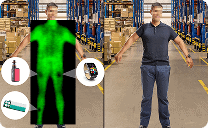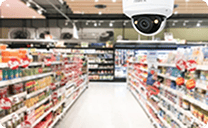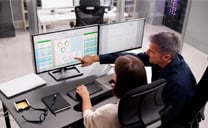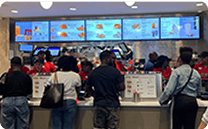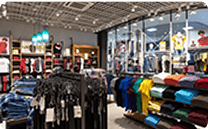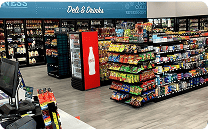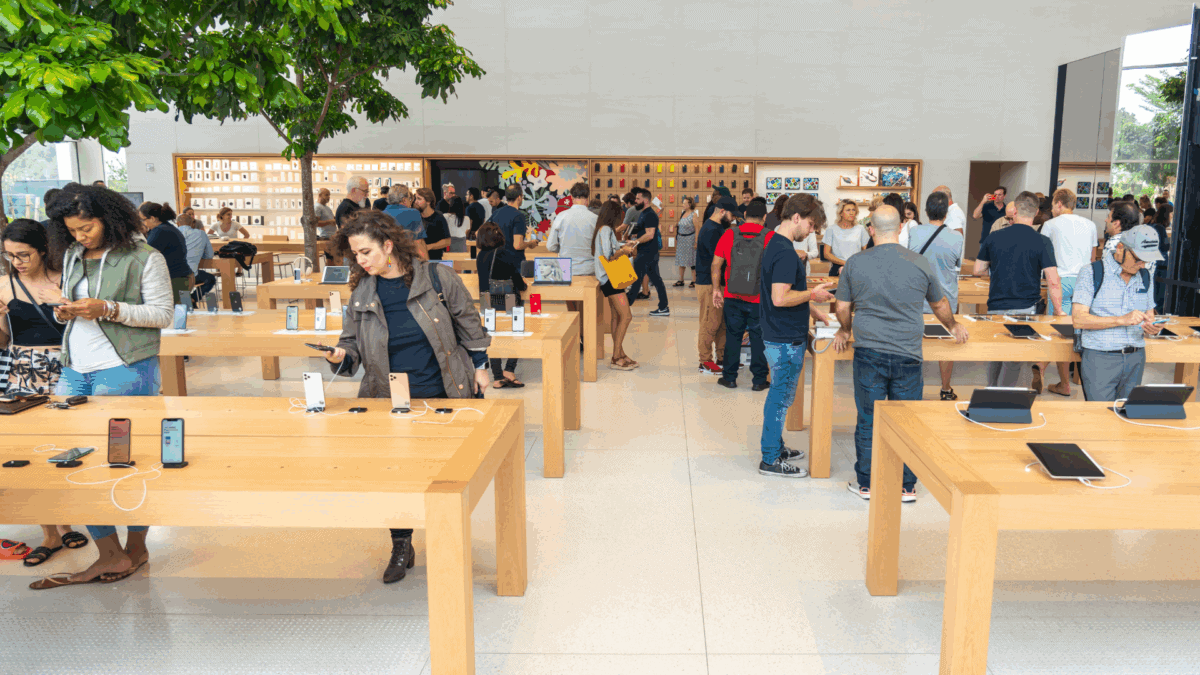Comprehensive Guide to Retail Security Solutions: Protecting Your Store and Profits
Introduction
Retailers of every size know their stores are painted with big red targets. With more than one million retail stores and 134.6 million primary household shoppers in the United States as of February 2025, there are many juicy targets. Shoplifters, thieves, fraudsters, and criminal organizations aim at those targets. Retailers, therefore, are eager, some even desperate, to implement retail security solutions to protect their stores and profits and sustain their businesses.
Every retailer has many security options, from retail video surveillance to retail access control to real-time stock tracking.
Video Surveillance and Analytics
Improving retail security requires the right devices and equipment and a commitment from ownership, management, and employees. Retail video surveillance is the primary security solution. To detect and deter those targeting retail stores, retailers must have a full array of strategically placed CCTV cameras thoroughly integrated with monitoring and other security systems.
- AI-powered surveillance – CCTV cameras have protected retail and other businesses for decades, but adding Artificial Intelligence (AI) has been a game changer. Object and facial recognition are more accurate, even from a distance, and motion detection can distinguish between regular and suspicious movements.
- Real-time monitoring—AI also powers monitoring systems that view objects, faces, and motions in real time. These systems can make more accurate and quicker assessments of what they see and respond appropriately.
- Behavioral analysis – AI and machine learning also boost retail store security. Video data is analyzed to learn behavioral patterns of intruders, customers, and employees. Technology can then predict the likelihood of a person being a shoplifter or thief.
- Suspicious activity detection – The advanced technology in CCTV cameras and monitoring systems can detect suspicious activities, such as loitering and spying on employee movements, almost instantly. Staff can deter unusual behaviors before they escalate into shoplifting, employee theft, and property damage.
Electronic Article Surveillance (EAS)
Electronic Article Surveillance (EAS) has been a proven and trusted retail loss prevention technology for over 60 years. Tags or labels with a sensor attached to merchandise are detected by antennas located at store exits or checkout counters. When a customer purchases an item, an employee deactivates the tag so the customer can leave the store without triggering the alarm. EAS is just one of several anti-theft devices:
- Radio Frequency Identification (RFID) – RFID is a technological leap forward from EAS. See more below.
- Retail video surveillance – AI-powered cameras are one of the most reliable retail security solutions. A complete and clear view of the shopping floor can help detect and deter shoplifting.
- Locked cases—Retailers like those selling high-value merchandise benefit from locked cases and cabinets to protect products from theft.
- Anti-theft shelves – Equip anti-theft shelves to prevent easy item removal, and use smart shelf technology to alert employees when someone removes a product.
- Employee training—Despite the significant advances in retail loss prevention technology, well-trained, aware, and alert employees are the critical human element. They must recognize a possible shoplifting incident in progress and know how to respond safely.
Access Control Systems
Retailers must strike a balance between comprehensive retail access control to protect all their assets and a welcoming and safe retail customer experience. Security gates are used to control access to designated areas. Retailers who sell high-value merchandise may find it prudent to install a keycard/biometric scanning system for employee and vendor access.
Access controls prevent unauthorized individuals from entering restricted areas while confirming that those entering are authorized. Once inside, however, managing employee and customer flow enhances other retail security solutions. Managing that flow benefits retailers in two ways: it maximizes security and improves operations.
- Shopping floor view – When staff have a complete view of the shopping area, they can quickly follow customer movements and recognize and respond to suspicious activities.
- Employee activities – Employees usually have assigned work or store positions. Being aware of their movements and any activities contrary to their work can alert management to possible employee theft and fraud.
- Accident prevention – Customer flow patterns, especially during peak hours or seasons, can provide management with insights to improve the store layout and minimize accidents.
- Happy customers—Implementing better customer flow positively affects customers who want to navigate a busy store safely. Retailers may benefit from more customer loyalty, increased sales, and a more attentive staff.
- Staffing efficiencies—By fully understanding employee and customer flow, labor costs can be better controlled by matching employee schedules with peak shopping periods.
Intrusion Detection and Alarm Systems
Intrusion detection and alarm systems are crucial retail security solutions, giving retailers another layer of deterrence. Retail stores are also targets when they’re closed. They require protection from unauthorized access and the resulting losses from inventory theft and damage caused by vandalism. Occasionally, employees could be in a store after hours. Intrusion detection and alarm systems are needed to keep them from harm.
Retailers have many options to deter intruders, receive alerts immediately, and respond rapidly and safely. These retail security solutions are also critical in emergencies and natural disasters.
- Alarm systems – When paired with various sensors, alarm systems alert staff of possible unauthorized intrusions. Fire and emergency alarms with sirens or flashing lights can help customers and employees exit the store quickly.
- Security sensors – One group of sensors triggers alarms for intrusion incidents, such as opening doors and windows, breaking glass, and motion detection.
- Environmental sensors—Use environmental sensors to trigger alarms when temperatures shift significantly, carbon monoxide is present, or air quality drops.
- Rapid response mechanisms – Connect alarms to monitoring devices that automatically notify staff by phone or text for rapid response.
- Evacuation practices—Some intrusions, especially organized retail crime incidents, may warrant an evacuation of a retail store. Employees thoroughly trained in these practices can usher customers quickly and safely out of the store.
Inventory Management and RFID Technology
A retail store’s inventory is the target of almost every type of retail thief, which is how most shrinkage occurs. Strong inventory management best practices protect from loss and ensure more accurate real-time stock tracking. Therefore, inventory needs the protection of retail loss prevention technology.
RFID technology evolved from EAS systems, providing the same type of alert system when unpaid merchandise is taken from a store. Tags equipped with a microchip and antenna are affixed to each item. A reader device sends a signal, which activates a tag. It then responds with its unique code. The reader receives the code, identifies the tag, and sends the data to a system. RFID allows for automation of inventory management and security oversight and is easily integrated into retail security and POS systems.
Strong inventory management best practices lead to streamlined merchandise replenishment and improved discrepancy identification, resulting in many benefits for ownership, employees, and customers.
Employee Training and Awareness
Retailers can implement all the retail security solutions they want, but they’re useless without thorough employee training—and retraining—as security circumstances change and new technologies are added. Teaching employees to be more aware is an essential training module. Heightened awareness of all store activities equips employees to contribute to loss prevention.
General security training and awareness training, specifically, develop a more professional mindset in employees, allowing them to provide a better retail customer experience. To achieve this goal, retailers have a healthy list of employee training strategies for their stores.
- Alert to suspicious activities—Scanning the various areas of a retail store periodically is a good first step towards better employee awareness. Employees must know the profiles of shoplifters, thieves, and intruders and how they may act suspiciously, from placing merchandise under their coats or in a bag to wandering through the aisles with no clear intent.
- Familiarity with security systems – Most retail stores don’t have security personnel, so employees must be familiar with the entire security system and demonstrate competence with its use.
- Loss prevention – Because inventory is the ultimate target of shoplifters and thieves, employees must also be well-versed in the store’s inventory system and best practices and use real-time stock tracking to spot missing merchandise and detect internal theft.
- Responding to emergencies – Employees also require training in how to respond to incidents and emergencies, especially violence on the premises. Employees should know evacuation routes, emergency contact information, and how to notify local law enforcement.
- Creating a security culture—Retailers are responsible for developing an employee culture of security and safety. Employees should be encouraged to report suspicious activities without concern for any consequences. Local law enforcement can visit the store regularly to create a cooperative relationship.
Customer Experience Considerations
When planning retail security solutions, retailers must consider the customer perspective since they expect a welcoming and safe retail customer experience. No retailer wants a security incident while a store is filled with customers, but it can and has happened. Customers will also judge their safety in a store by how employees respond to an incident.
- Balancing security measures—Retailers want the benefits of retail loss prevention technology, but utilizing those technologies can’t intrude on customers’ shopping trips. These devices and equipment should be installed in discrete locations and be visible to customers, indicating that the retailer is proactive about security and safety.
- Managing customer flow—Employee training should also include awareness of customer flow. Bottlenecks at specific locations may indicate that displays and racks must be realigned, making it easier for employees to respond to security incidents. Creating a separate, roped-off checkout aisle allows employees to view customer activities.
- Security signage – Strategically placed signage that notifies customers of live security cameras and the potential for alarms to sound is another indication of the retailer’s dedication to security and safety.
Conclusion
Planning and implementing retail security solutions is near the top of retailers’ responsibilities and requires constant attention. Inventory must be protected from shrinkage caused by theft and fraud, and customers and employees must be able to shop and work safely and securely.
Retail security is so critical that the security industry now offers a complete array of retail loss prevention technology. The advancements in these technologies add another layer of security. AI-powered cameras produce sharper images and recognize objects, faces, and motions. Real-time monitoring means faster response times to incidents, and algorithms can analyze video data to understand customer and employee behavior patterns.
Retail security solutions also include tighter inventory control with RFID technology, employee training and awareness skills, and balancing security needs with an outstanding retail customer experience.
To learn more about DTiQ’s solutions for retail security, visit our website.
Frequently Asked Questions
Q: Why is retail security important?
A: Retail security solutions are the bulwark against inventory loss from shrinkage, shoplifting, theft, employee and supplier fraud, cybercrime, and any other means used to access a store and its inventory unlawfully. Retail security also creates a safe environment where customers can enjoy shopping, increase their spending, and return many times to spend more. Employees can focus on being more productive and apply the skills they learned in staff security training to be more aware of customer flow and suspicious activities.
Q: Which retail loss prevention technology is needed to protect a store?
A: Every retail store requires three technology categories to protect against intruders, shoplifters, employee theft, and all other unauthorized access. Retail access control is the first category, utilizing keycards/biometrics authentication, restricted entry areas, and other barriers. Retail video surveillance is the second category, especially AI-powered cameras. They have advanced technology to recognize objects and faces and detect motion. Employees or security personnel can watch camera views in real-time and evaluate video data remotely when paired with monitoring stations. The third category is alarm/alert technology. These are integrated with CCTV cameras and other equipment in a security system and are triggered automatically, alerting staff to possible intrusions or other incidents.
Q: Which retail loss prevention technology is needed to protect a store’s inventory?
A: EAS and RFID technology have proven their worth for many years. EAS alerts staff that an item has been removed from the store without payment. Tags or labels with a sensor are attached to merchandise. These can be detected by antennas located at store exits or checkout counters. RFID technology evolved from EAS systems. Tags equipped with a microchip and antenna are affixed to each item. A reader device sends a signal, which activates a tag. It then responds with its unique code. The reader receives the code, identifies the tag, and sends the data to a system.
Q: Why is employee training a critical component of retail security solutions?
A: Without comprehensive employee training, the retailer’s other retail security solutions will be underutilized and not achieve the desired security goals. Employee security training consists of several modules. First are the skills to recognize suspicious activities and respond safely. Second is familiarity with the store’s security systems, from retail access control to CCTV cameras and monitoring equipment. Third is understanding how EAS and RFID technologies and real-time stock tracking work. Fourth is embracing a store security culture, which is the responsibility of ownership, so everyone is focused on using retail security solutions to prevent loss.
